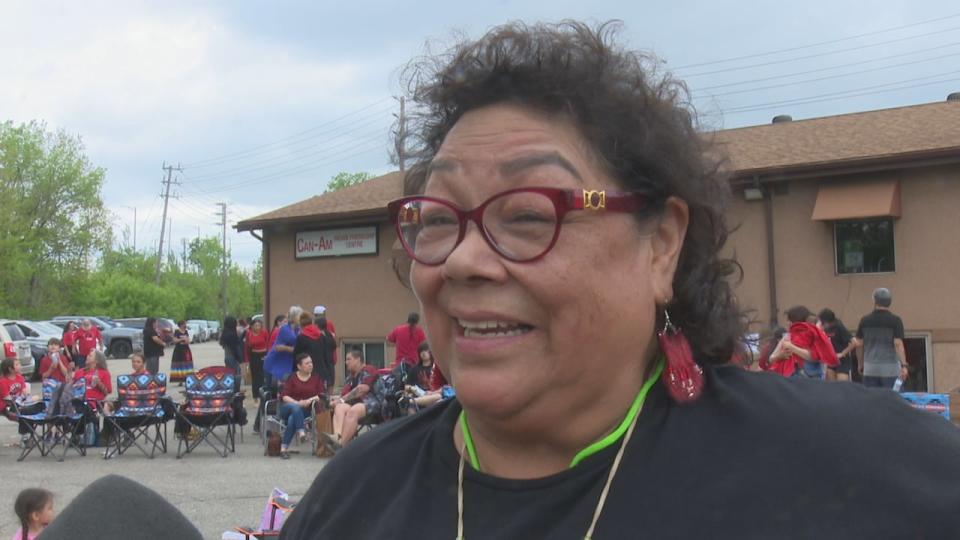Red Dress Day recognizes Indigenous lives lost in Windsor and far beyond, say organizers

Red Dress Day began as a memorial for missing and murdered Indigenous women and girls across Canada — but for some attendees of a Windsor, Ont., gathering on Sunday, the awareness campaign relates to situations elsewhere in the world.
"Nothing has changed. The plundering of the land, the murder," said Mona Stonefish, an elder of the Anishinaabe alliance known as the Three Fires Confederacy."
"We're still going to love, and we're still going to fight, because we have to find a way to stop the violence. Not only here, but all over the world," Stonefish continued.
"I have to mention Gaza, because education is one of the greatest tools that we have... There are thousands of women and children being murdered (there). And it's the same thing that happened to us here in Canada."

Tracey Whiteye leads a ceremonial circle in recognition of Red Dress Day at the Can-Am Indian Friendship Centre in Windsor on May 5, 2024. (Dalson Chen/CBC)
Members and supporters of the Can-Am Indian Friendship Centre of Windsor marked May 5 — the designated date of Red Dress Day — with a ceremonial circle around a fire.
Red Dress Day started in 2010 at the University of Winnipeg, when Metis artist Jaime Black hung empty red dresses to symbolize the toll of violence upon Indigenous women, and Indigenous people in general.

Empty red dresses hang on a fence at the Can-Am Indian Friendship Centre in Windsor as part of a symbolic display on Red Dress Day. (Dalson Chen/CBC)
Red dresses similarly decorated a fence at Sunday's gathering at the Can-Am Indian Friendship Centre.
Attendees also marked the occasion by wearing red clothing, along with the acronym MMIWG (Missing and Murdered Indigenous Women and Girls).

Attendees of the ceremonial circle on Red Dress Day at the Can-Am Indian Friendship Centre in Windsor on May 5, 2024. (Dalson Chen/CBC)
Some attendees wore a red hand print on their faces — a custom started by the American Indian Movement.
"Because (oppressors) have tried to silence us," Stonefish explained. "There are cases that have not been brought to justice."
"We have cases right here in Windsor that have become cold case files."

Mona Stonefish at the Can-Am Indian Friendship Centre in Windsor. (Dalson Chen/CBC)
Stonefish pointed to the case of Diane Dobson of Saugeen First Nation, whose battered body was found in a ditch in Windsor's Brighton Beach in 1995. The cause of death was a blow to the head. Her killer was never found.
"It is my dream that we all value life — the gift of life," Stonefish said. "No one has the right to murder."

Amberley John of the Can-Am Indian Friendship Centre in Windsor. (Dalson Chen/CBC)
Amberley John, the centre's cultural resource coordinator, said Red Dress Day is a reminder that violence against Indigenous people "impacts us every day of the year."
"There's a lot of stereotypes and myths and misunderstandings about (missing and murdered Indigenous women)," said John, whose heritage is the Oneida people.
"I'd really like people to understand what the issue is. This society is built on colonialism. It's basically founded on white supremacy and the Doctrine of Discovery, which dehumanized Indigenous people. People should know that. That's the history here."
Like Stonefish, John feels there's a connection between Red Dress Day and the conflict in Gaza.
"I just wanted to also acknowledge the women in Palestine right now," John said.
"They're part of the global Indigenous community. We're thinking about them today, as well."

A sign at the Red Dress Day gathering at the Can-Am Indian Friendship Centre in Windsor on May 5, 2024. (Dalson Chen/CBC)
Tracey Whiteye, the centre's executive director, led Sunday's gathering in a pipe ceremony, a moon ceremony, and a water ceremony.
"We all, collectively, put our knowledge together. My knowledge comes from ceremony," said Whiteye, whose heritage is the Lenni Lenape people of the Thames River.

Tracey Whiteye, executive director of the Can-Am Indian Friendship Centre in Windsor. (Dalson Chen/CBC)
Whiteye believes that recognizing the importance of the feminine is part of being First Nations — which adds further symbolism to Red Dress Day.
"We're a matriarchy," Whiteye said. "The ceremonies, I learned from my grandmas and elders. When I talked about water, that water's feminine. When I talked about Grandmother Moon, she's feminine. When we talk about Mother Earth, she's feminine... Feminine is part of the leadership. That's natural law."

Red dresses hang on a fence at the Can-Am Indian Friendship Centre of Windsor on May 5, 2024. (Dalson Chen/CBC)


